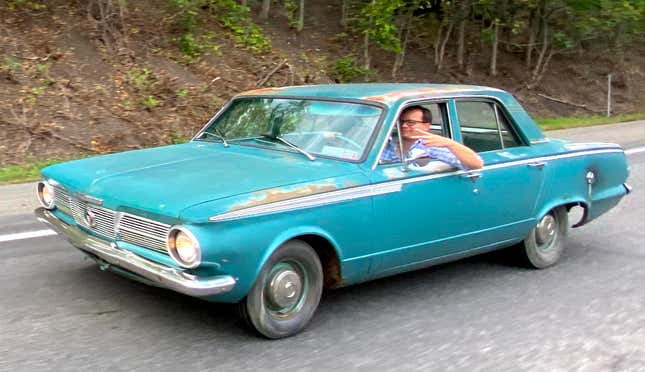
I just finished a 3,000-mile road trip from Los Angeles to upstate New York in a U-Haul truck and Mitsubishi Montero (I was helping my friend and former Jalop Andrew Collins move). Since I need to somehow get back to my house in Michigan, I had no choice but to buy a car. So on a whim, I purchased a 1965 Plymouth Valiant, and though it may look like just a standard old 1960s sedan, trust me: There was a method to my madness.
Andrew keeps telling me that there is a cheaper, easier way to travel long distances — something having to do with “1/2 ρ V2 × S × CL” — but I’m just not buying it. We all know that the most effective way to go anywhere is to travel by Plymouth. And not just any Plymouth, one powered by the Leaning Tower of Power.
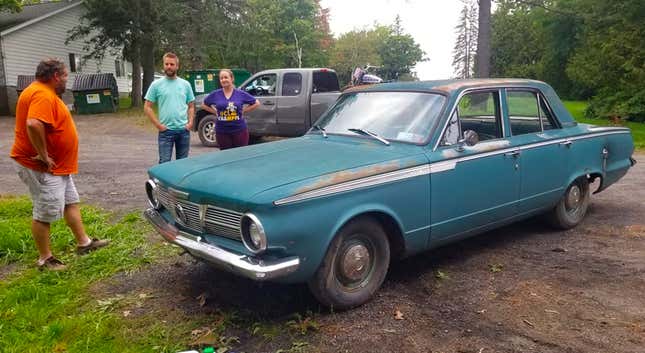
That’s the nickname for the most unkillable American motor in history: The Chrysler slant six — so named for the 30-degree angle that its cylinder bores make with the Z-axis (Aside: in the auto engineering world, the X-axis runs the length of the car, Y-axis runs cross-car, and Z-axis goes up and down). Mac’s Motor City Garage, a website devoted to car culture, breaks down the reason behind the motor’s lean:
...The cylinders laid over 30 degrees...permitted a significantly lower cowl and hood height, a key element in the Valiant’s distinctive styling, and it also made room for long, straight intake manifold runners for improved fuel/air distribution, a traditional trouble spot in inline-six layouts.
[...]
With the cylinders laid over 30 degrees, the water pump could be placed alongside the block instead of in front, shortening the engine’s footprint by a good four inches.
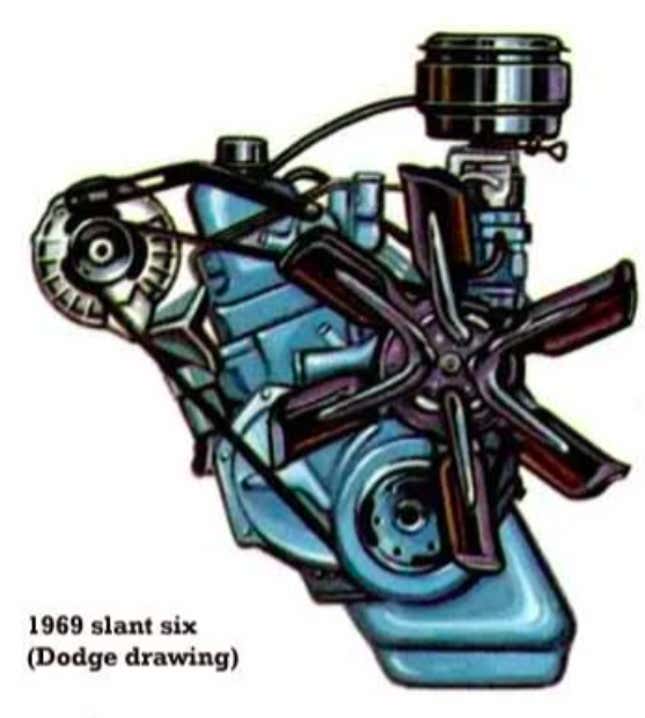
By modern standards, this is an old-school engine, though in 1960, it was replacing flathead motors whose valves were in the engine block. In a flathead engine, the pistons move down and take air in through a carburetor perched atop an intake manifold. Once through the carb, that air goes through the manifold and up through the intake valve, then flows laterally across the engine, down the bore, back up during the piston’s exhaust stroke, across the the engine again, and then down through an exhaust valve. The exhaust is expelled through an exhaust manifold and exhaust pipe.
Though in the late 1950s many vehicles also had “F-head” designs in which one valve was directly above the cylinder bore, this still wasn’t as efficient as the purely overhead valve setup that really caught on in the 1950s and that dominates the auto industry today (though today’s engines also have camshafts above the cylinders, and are called “overhead cam” engines; “overhead valve” usually refers to cam-in-block pushrod engines, but this is getting into the weeds a bit).
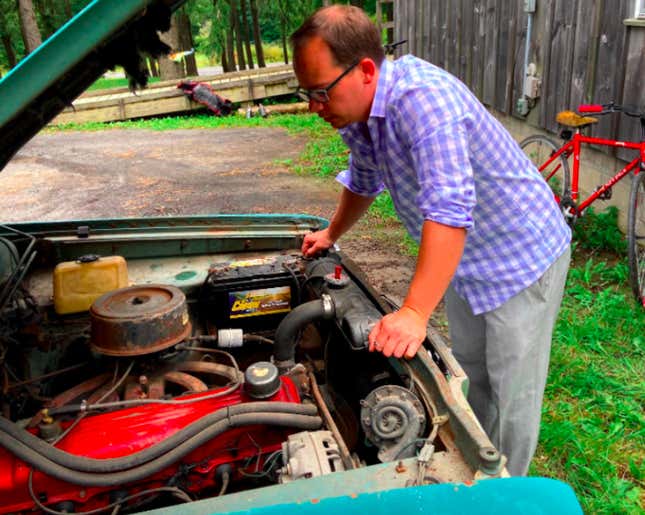
So yes, the Leaning Tower of Power had overhead valves, so it isn’t that antiquated, but trust me: it was still incredibly basic. The lifters (there’s one pointed out below) — little metal cans that ride along the camshaft, and that are meant to take up any slop between that camshaft and the pushrods that open valves via rocker arms — were solid instead of hydraulic. What this means is that, as parts of the valvetrain (valve, valve seat, camshaft, rocker, pushrod) wear down, the owner has to go in and use a pair of wrenches to elongate the lifter to remove slop. Hydraulic lifters use pressurized oil to eliminate valvelash, and require no manual adjustment.

The Chrysler Slant Six also came with a single barrel carburetor — a flow-choking, tiny little cast aluminum contraption that mixes fuel and air before sending it into the engine. There’s so much more to the engine that’s antiquated, like old-school breaker points instead of electronic ignition and cast iron construction, but that’s okay, because the thing is unkillable.
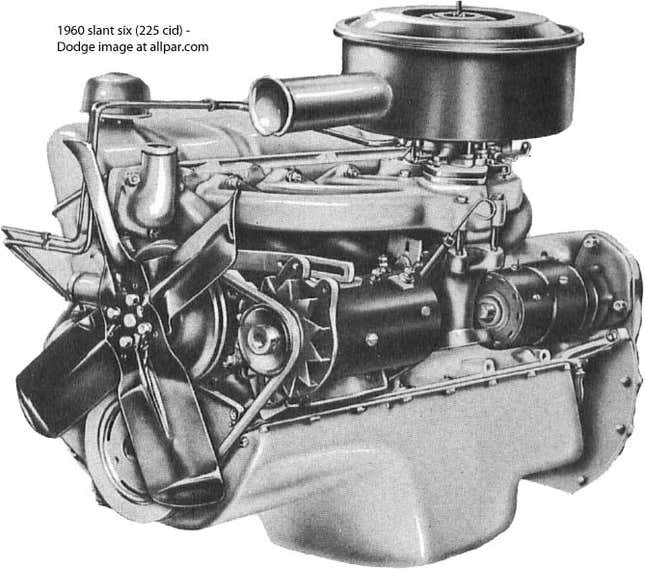
The engine was a big deal when it came out, and so was its debut-vehicle, the Valiant, which wasn’t officially called a Plymouth until 1961. The Valiant was Chrysler’s compact sedan meant to compete with Chevy’s Corvair and Ford’s Falcon. Designed by the man who played a big part in the proliferation of humongous tail fins in the 1950s, Virgil Exner, the first-gen Valiant was an odd-looking machine, but it was popular.
It offered AC, a push-button automatic transmission, unibody construction, multiple body styles (two-door, four-door, wagon), and became a mainstay of American vehicular transport for decades.
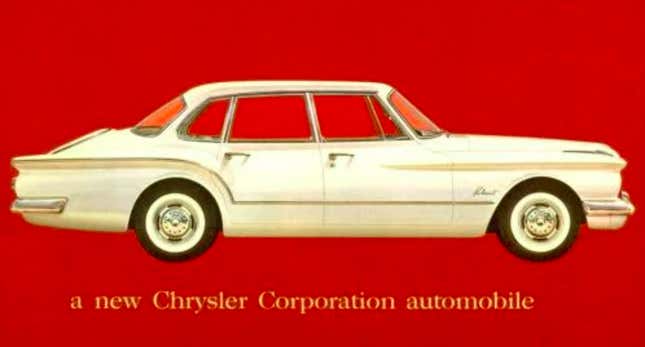
Exner even built the Plymouth XNR concept on the Valiant’s bones in 1960, using the vehicle to highlight the new slant-six’s capabilities:
The simplicity of the slant six engine design, its relatively modest output, and the quality of the main rotating parts (including a forged crankshaft) as well as the effective cooling and lubrication systems, meant these engines lasted forever. Find any “most reliable engines of all time” list on the internet, and the Chrysler slant six will be on it.
This is why I bought my 1965 Plymouth Valiant. I want a winter car to replace my Lexus LX470, which is a swell vehicle, but worth too much for me to let rust out on Michigan’s salty roads, and a bit boring and thirsty, with its four-speed slushbox and ridiculous curb weight. I want something fun to drive in the winter, and few things are as fun as a three-speed column-shift manual transmission.

I spotted the car on upstate New York’s Facebook Marketplace with an asking price of $2,835. Andrew and his wife Sydney drove me over an hour to a Christian bible camp, where the man who runs the place showed me his wasp-infested Valiant, which he swore had only 51,500 original miles (this, I later learned when going through the service records, was false; the notes clearly show the vehicle eclipsing 100,000 miles).
The man was nice (to me, not the wasps; he murdered them viciously — odd behavior for someone who runs a bible camp, but also maybe not), but didn’t know much about his car. He’d only owned it for a few years, and couldn’t tell me whether first gear is synchronized (it is not). Is it a bit alarming that he didn’t know the answer to that? Yes, a bit. I’ll change the transmission fluid as soon as I can to drain out chunks of first gear teeth.
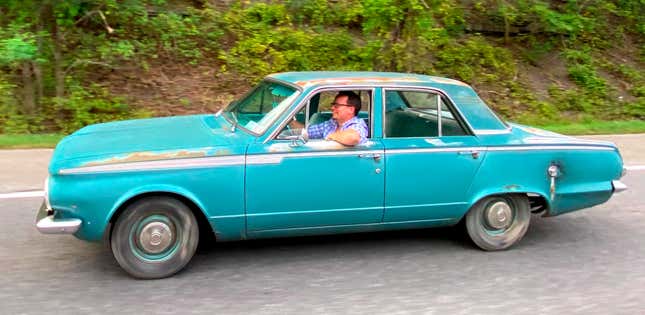
The test drive went well; motor fired up quickly, and the transmission was quiet. I handed the seller $2,000, he signed his registration, and I was off. Well, after filling the motor with a quart of oil, the radiator with nearly a gallon of coolant, and the single brake fluid reservoir with a splash of DOT 3.
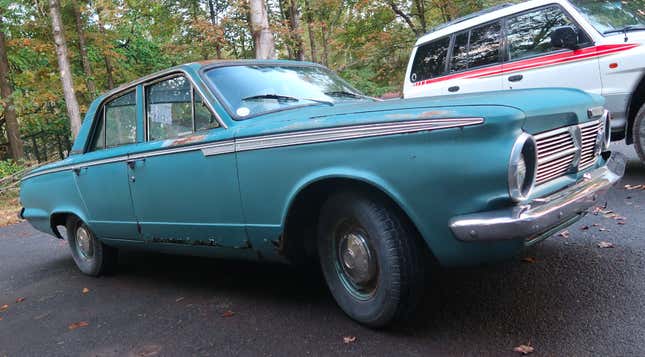
Following Andrew’s Mitsubishi Montero, I drove the Valiant 60 miles from the bible camp to my friend’s house, and fell head-over-heels in love. The three-speed column-shift transmission is sublime; it’s fun to shift, and goes into all three gears (plus reverse) smoothly. The smooth-revving slant-six is just incredible, offering plenty of torque, and never stuttering under acceleration. Sure, there’s some vibration under load; neither the fuel gauge nor the coolant temperature gauge works; and there’s plenty of rust on the floorboards, doors, and quarter panels (the main unibody rails are solid); but I don’t care. This regular old 1960s Plymouth sedan — with its blue interior filled with two three-person bench seats — has my heart.
Well, for now, that is. This machine still has to get me 650 miles from upstate New York to Michigan; only then will I know whether it deserves the title of “Most reliable American car ever.”